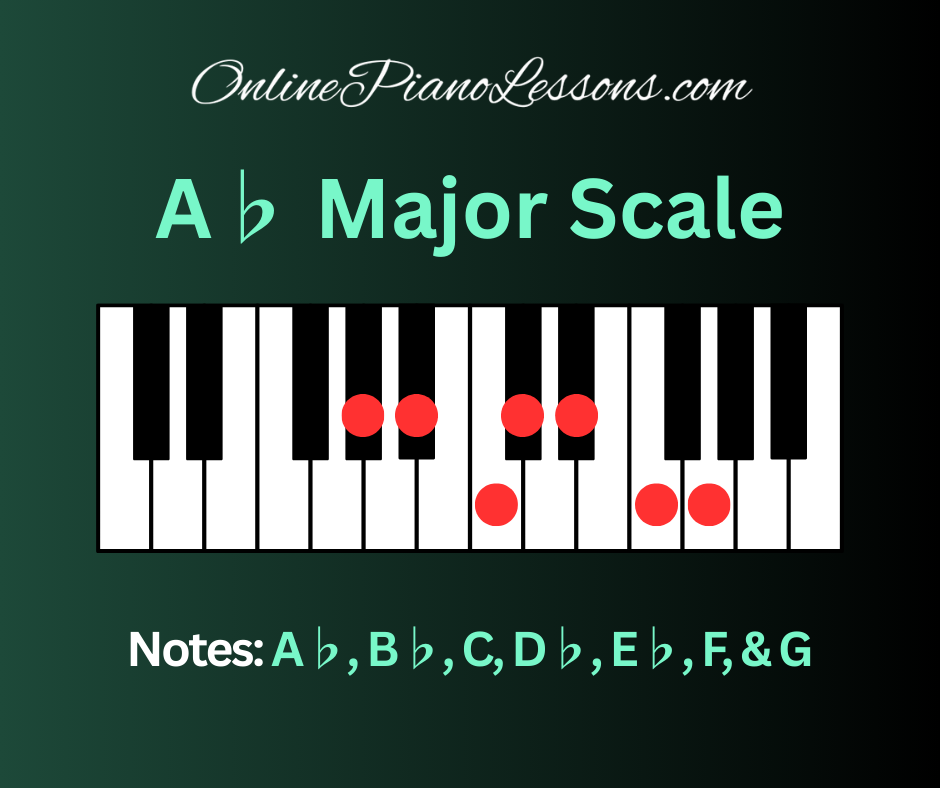
The A flat major scale is one of the most elegant and warm-sounding scales on the piano. Known for its smooth, rich tone, the A♭ major scale is widely used in classical music, jazz, and contemporary compositions. Whether you are a beginner learning your first scales or an advanced pianist seeking to expand your repertoire, mastering the A flat major scale is an essential skill.
This definitive guide will explore what the A flat major scale is, how to find it on the piano, how it works in music theory, what it sounds like, and practical tips for mastering it.
What Is the A Flat Major Scale?
The A flat major scale is a diatonic scale that begins on the note A♭ and follows the major scale pattern of whole and half steps. It is characterized by four flats in its key signature: B♭, E♭, A♭, and D♭. This configuration gives the A♭ major scale a smooth, mellow tone that is immediately recognizable when played on the piano.
The notes of the natural A flat major scale are:
- A♭
- B♭
- C
- D♭
- E♭
- F
- G
- A♭ (octave)
The pattern of intervals for a major scale is:
Whole – Whole – Half – Whole – Whole – Whole – Half
This pattern allows pianists to construct any major scale from any starting note, including the A♭ major scale, which is especially popular for its rich harmonic potential.
How to Find the A Flat Major Scale on the Piano
Locating and playing the A flat major scale on the piano is relatively straightforward once you can identify A♭. On the keyboard, A♭ is the black key immediately to the left of A.
To play the A♭ major scale, follow this step-by-step pattern:
- Start on A♭
- Whole step to B♭
- Whole step to C
- Half step to D♭
- Whole step to E♭
- Whole step to F
- Whole step to G
- Half step to A♭ (octave)
This simple method ensures you can navigate the A♭ major scale efficiently on the piano, even if you are a beginner.
Why the A Flat Major Scale Matters in Music
The A♭ major scale is not only pleasing to the ear but also foundational for understanding music theory and harmony on the piano. It helps pianists:
- Develop hand coordination and finger strength
- Understand major scale structure
- Explore harmonic relationships and chord progressions
- Improve sight-reading and improvisation skills
Many composers choose the A♭ major scale for its warm, expressive qualities, making it a favorite for romantic, classical, and jazz compositions.
Chords Derived from the A Flat Major Scale
Learning the chords of the A♭ major scale is crucial for harmonization, improvisation, and accompaniment. The primary triads are:
- I (A♭ major): A♭ – C – E♭
- ii (B♭ minor): B♭ – D♭ – F
- iii (C minor): C – E♭ – G
- IV (D♭ major): D♭ – F – A♭
- V (E♭ major): E♭ – G – B♭
- vi (F minor): F – A♭ – C
- vii° (G diminished): G – B♭ – D♭
These chords allow pianists to create rich, full harmonies and understand how melodies from the A♭ major scale interact with chord progressions.
How the A Flat Major Scale Sounds
The A♭ major scale has a warm, lyrical sound that is often described as:
- Smooth
- Elegant
- Relaxed
- Romantic
- Rich
- Harmonically pleasing
On the piano, the combination of black and white keys in the A♭ major scale creates a natural hand position that makes playing scales, chords, and arpeggios feel fluid and comfortable. This accessibility is part of what makes the A♭ major scale popular among pianists of all levels.
Famous Pieces in A Flat Major
Several famous compositions and piano works utilize the A♭ major scale, highlighting its expressive capabilities:
- Beethoven’s Piano Sonata No. 8 (Pathétique), second movement
- Chopin’s Nocturne in A♭ Major, Op. 32 No. 2
- Schubert’s Impromptu in A♭ Major, Op. 90 No. 4
- Jazz standards like “Misty” by Erroll Garner
Practicing these pieces helps pianists internalize the sound and feel of the A♭ major scale while developing technical proficiency.
How to Practice the A Flat Major Scale on the Piano
Mastering the A♭ major scale requires consistent, structured practice. Here are key tips for effective practice:
Use Correct Fingering
Correct fingering ensures smooth playing and prevents hand strain.
Right Hand (one octave):
3 – 1 – 2 – 3 – 1 – 2 – 3 – 1
Left Hand (one octave):
3 – 2 – 1 – 3 – 2 – 1 – 3 – 1
Using consistent fingering builds muscle memory, making the A♭ major scale easier to play at faster tempos.
Start Slowly
Begin at a comfortable tempo to focus on accuracy. Gradually increase the speed as you become more confident.
Use a Metronome
Practicing with a metronome improves timing, consistency, and hand coordination.
Practice Hands Separately
Strengthen each hand independently before combining them for more precise playing.
Incorporate Arpeggios
Arpeggios derived from the A♭ major scale improve finger agility and understanding of harmonic relationships.
Common Mistakes When Learning the A Flat Major Scale
Even experienced pianists sometimes make mistakes with the A♭ major scale:
- Confusing flat notes with natural or sharp notes
- Inconsistent fingering between hands
- Playing too quickly without control
- Neglecting proper wrist movement
- Skipping arpeggio practice
Avoiding these mistakes ensures that you can play the A♭ major scale smoothly and confidently.
Why Pianists Should Learn the A Flat Major Scale
Learning the A♭ major scale offers several benefits for pianists:
- Strengthens hand coordination over both black and white keys
- Expands understanding of major key theory
- Improves improvisation and sight-reading skills
- Builds technical skills like speed, accuracy, and finger independence
- Prepares pianists for classical, jazz, and contemporary pieces
Whether you are a beginner or advanced pianist, the A♭ major scale is an essential tool for musical growth.
FAQ
How many flats are in the A♭ major scale?
The A♭ major scale has four flats: B♭, E♭, A♭, and D♭.
Is the A♭ major scale hard to play on the piano?
It can be challenging at first due to the black keys, but consistent practice makes it very manageable.
What chords come from the A♭ major scale?
The main chords are A♭ major, B♭ minor, C minor, D♭ major, E♭ major, F minor, and G diminished.
Why is the A♭ major scale important for beginners?
It develops hand coordination, finger strength, and understanding of major key theory.
Can I use the A♭ major scale for improvisation?
Absolutely. Pianists often use it for melodic improvisation and jazz comping because of its smooth, expressive tone.





 Hi, I'm Thomas, Pianist Composer,
Hi, I'm Thomas, Pianist Composer,  I love playing piano, creating new melodies and songs, and further developing my online piano course and making updates/additions to my site OnlinePianoLessons.com!
I love playing piano, creating new melodies and songs, and further developing my online piano course and making updates/additions to my site OnlinePianoLessons.com!  Now that is what I call fun!
Now that is what I call fun!





